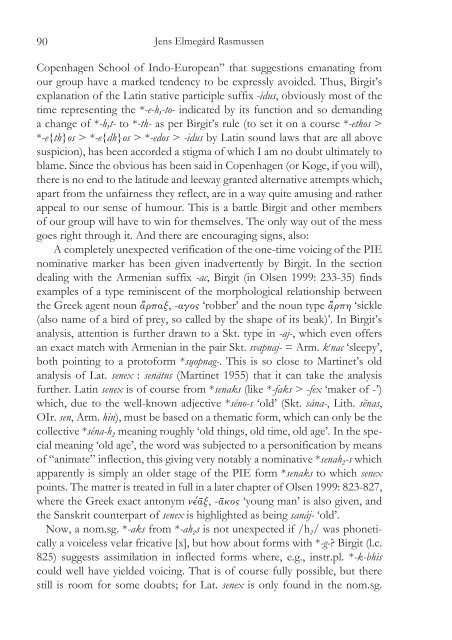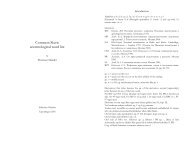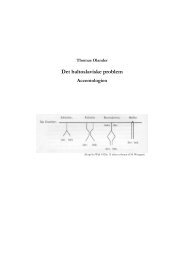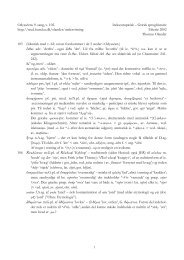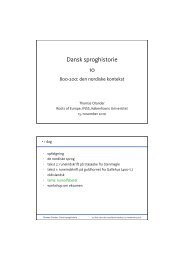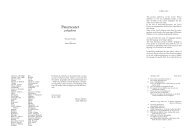Festschrift for Birgit Anette Olsen - sproghistorie · Thomas Olander
Festschrift for Birgit Anette Olsen - sproghistorie · Thomas Olander
Festschrift for Birgit Anette Olsen - sproghistorie · Thomas Olander
You also want an ePaper? Increase the reach of your titles
YUMPU automatically turns print PDFs into web optimized ePapers that Google loves.
90<br />
Jens Elmegård Rasmussen Tañgw wm dänqsg radsgrivneñ<br />
87<br />
Copenhagen School of Indo-European” that suggestions emanating from<br />
our group have a marked tendency to be expressly avoided. Thus, <strong>Birgit</strong>’s<br />
explanation of the Latin stative participle suffix -idus, obviously most of the<br />
time representing the *-e-h₁-to- indicated by its function and so demanding<br />
a change of *-h₁t- to *-th- as per <strong>Birgit</strong>’s rule (to set it on a course *-ethos ><br />
*-e{th}os > *-e{dh}os > *-edos > -idus by Latin sound laws that are all above<br />
suspicion), has been accorded a stigma of which I am no doubt ultimately to<br />
blame. Since the obvious has been said in Copenhagen (or Køge, if you will),<br />
there is no end to the latitude and leeway granted alternative attempts which,<br />
apart from the unfairness they reflect, are in a way quite amusing and rather<br />
appeal to our sense of humour. This is a battle <strong>Birgit</strong> and other members<br />
of our group will have to win <strong>for</strong> themselves. The only way out of the mess<br />
goes right through it. And there are encouraging signs, also:<br />
A completely unexpected verification of the one-time voicing of the PIE<br />
nominative marker has been given inadvertently by <strong>Birgit</strong>. In the section<br />
dealing with the Armenian suffix -ac, <strong>Birgit</strong> (in <strong>Olsen</strong> 1999: 233-35) finds<br />
examples of a type reminiscent of the morphological relationship between<br />
the Greek agent noun ἅρπαξ, -αγος ‘robber’ and the noun type ἅρπη ‘sickle<br />
(also name of a bird of prey, so called by the shape of its beak)’. In <strong>Birgit</strong>’s<br />
analysis, attention is further drawn to a Skt. type in -aj-, which even offers<br />
an exact match with Armenian in the pair Skt. svapnaj- = Arm. k c nac ‘sleepy’,<br />
both pointing to a proto<strong>for</strong>m *su̯opnag-. This is so close to Martinet’s old<br />
analysis of Lat. senex : senātus (Martinet 1955) that it can take the analysis<br />
further. Latin senex is of course from *senaks (like *-faks > -fex ‘maker of -’)<br />
which, due to the well-known adjective *séno-s ‘old’ (Skt. sána-, Lith. sẽnas,<br />
OIr. sen, Arm. hin), must be based on a thematic <strong>for</strong>m, which can only be the<br />
collective *séna-h₂ meaning roughly ‘old things, old time, old age’. In the special<br />
meaning ‘old age’, the word was subjected to a personification by means<br />
of “animate” inflection, this giving very notably a nominative *senah₂-s which<br />
apparently is simply an older stage of the PIE <strong>for</strong>m *senaks to which senex<br />
points. The matter is treated in full in a later chapter of <strong>Olsen</strong> 1999: 823-827,<br />
where the Greek exact antonym νέᾱξ, -ᾱκος ‘young man’ is also given, and<br />
the Sanskrit counterpart of senex is highlighted as being sanáj- ‘old’.<br />
Now, a nom.sg. *-aks from *-ah₂s is not unexpected if /h₂/ was phonetically<br />
a voiceless velar fricative [x], but how about <strong>for</strong>ms with *-g-? <strong>Birgit</strong> (l.c.<br />
825) suggests assimilation in inflected <strong>for</strong>ms where, e.g., instr.pl. *-k-bhis<br />
could well have yielded voicing. That is of course fully possible, but there<br />
still is room <strong>for</strong> some doubts; <strong>for</strong> Lat. senex is only found in the nom.sg.<br />
pen, labben}, kädn {katten}, lenz {linned}; jf. enstavelsesordene sajlq {sejl, segl},<br />
hörmq {hørm}, havnq {havn}. Lyden z optræder ikke efter konsonant. Stavelsesdannende<br />
l m n efter j r v og stavelsesdannende l m n z i <strong>for</strong>bindelse med<br />
vokaler tolkes som en følge af to ens segmenter, fx kajll {kegle}, havnn {havne};<br />
ramm {ramme, rammen}, pell {pille}, sezz {sidde, siddet}; sbænnë {spændende};<br />
kädnnë {kattene}.<br />
De prosodiske træk der findes i moderne københavnsk rigsmål, noteres på<br />
følgende måde:<br />
Tryk: Ved ord med tryk på første stavelse noteres trykkets placering<br />
ikke. Ved ord har tryk på en anden stavelse end den første, skrives<br />
en apostrof (’) før den betonede vokal, fx beg’äqo {begave}.<br />
Stød: Stød skrives q efter det segment der er karakteriseret heraf, fx viql<br />
{hvil}, vilq {vild}.<br />
Længde: Lange vokaler markeres med dobbeltskrivning, fx laamw {larmer].<br />
Af fonemer med betydelige allofoniske varianter i <strong>for</strong>skellig stilling må<br />
nævnes v der i stavelses<strong>for</strong>lyd er en labiodental frikativ [v], men i stavelsesudlyd<br />
en bilabial halvvokal [u̯]. Ligeledes realiseres r i <strong>for</strong>lyd som den uvulære<br />
lyd [ʁ̞], men i udlyd som en halvvokal [ɐ̯]. Det bør dog overvejes at tolke [u̯]<br />
og [ɐ̯] som postvokaliske allofoner til vokalerne u og a.<br />
Især hos yngre sprogbrugere finder vi en udtale af lydfølgen rö som rw, fx<br />
grwnq {grøn}. Derved kan ö i ord som {gør}, {gøre} <strong>for</strong>tolkes som en allofon (i<br />
position ikke efter r, men før r og w) til ë, altså gër, gëw. I nærværende tolkning<br />
vil ö dog blive betragtet som et selvstændigt fonem.<br />
Som i mange andre sprog er det også i dansk <strong>for</strong>bundet med store vanskeligheder<br />
at give en præcis definition af et “ord”. Indtil videre vil det være<br />
værd at bemærke at en del faste <strong>for</strong>bindelser af præposition og styrelse i RDR<br />
analyseres som ét ord og skrives i overensstemmelse hermed, fx tesd’æzz {til<br />
stede}, id’äq {i dag}, i’älqd {i alt}, i’øvri {i øvrigt}. Desuden wvqwfw (bañqgñ) {over<br />
<strong>for</strong> (banken)} o.l.<br />
Når præsens af kopulaverbet väw {være} er betonet, skrives det ä(r) (fx ja<br />
ä(r) da älwräzz {jeg er der allerede}). Når <strong>for</strong>men er ubetonet og står efter et<br />
ord der ender på konsonant, skrives den -ä (fx hun-ä gläz {hun er glad}). Når<br />
<strong>for</strong>men er ubetonet og står efter et ord der ender på vokal, skrives den med<br />
bindestreg efterfulgt af det <strong>for</strong>udgående vokaltegn (fx ja-a gläz {jeg er glad},<br />
du-u trad {du er træt}).


